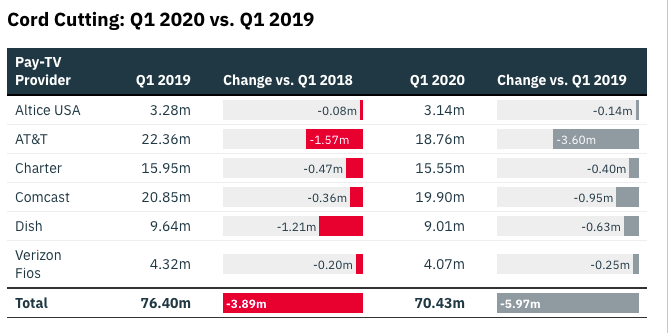Cord-Cutting Explodes in Q1 as Pay-TV Sector Delivers Worst-Ever Losses
- The Tech Platform

- May 17, 2020
- 2 min read
Traditional cable and satellite TV providers posted their most massive quarterly subscriber losses in the first three months of 2020, as the COVID-19 tornado started to hit the U.S. economy in March. What’s more, internet-delivered “virtual” TV providers registered a net loss in the period, too.
And the cord-cutting bleeding is only going to get worse in Q2, as the economic fallout from the coronavirus takes a deeper bite, analysts predict.
The combination of high prices — amid the backdrop of record unemployment — as well as loss of live sports fueled an overall drop of 1.8 million pay-TV subscribers in Q1, per estimates by Wall Street analyst firm MoffettNathanson. That translates into an annual rate of decline of 7.6%, the fastest shrinkage of the sector on record.
“At 63% of occupied households, traditional pay TV penetration has reached a level not previously seen since roughly 1995,” analyst Craig Moffett wrote in a research note Friday. “There are now as many non-subscribing households (46M) as there were pay TV subscribers in 1988.”
As cord-cutting accelerates, the growth of cable networks’ affiliate fees has also been decelerating in the U.S., UBS Securities analyst John Hodulik said in a note Friday.
“We believe the [coronavirus] outbreak could drive modest acceleration in cord-cutting in the lockdown phase but more dramatic declines post-lockdown given the expected recession,” Hodulik wrote. “The absence of sports should pressure sports nets in the near term as distributors balk at paying high fees and post-lockdown if sports (especially professional and college football) do not return in the fall, potentially creating a cord-cutting perfect storm.”
In Q1, the losses disproportionately fell on satellite TV: AT&T shed a whopping 1 million TV subscribers, mostly from DirecTV, while Dish Network dropped a net 413,000, the company’s biggest-ever quarterly loss.
Meanwhile, virtual pay-TV players, which include AT&T TV Now, Dish’s Sling TV, Hulu + Live TV, YouTube TV and FuboTV, collectively lost an estimated 341,000 subscribers in Q1, per Moffett’s calculations. That indicates that former subs to Sony’s PlayStation Vue — which ceased service at the end of January — “appear to have gone… nowhere,” he added.
The only notable subscription-TV services to add subscribers in the first quarter of 2020 were Hulu + Live TV — which picked up about 100,000 to stand at 3.2 million — and Google’s YouTube, which netted approximately 300,000 to reach 2.3 million per Moffett’s estimate.
Amid the cord-cutting pain, large media companies — Disney, NBCUniversal and WarnerMedia — have launched or are about to launch direct-to-consumer streaming services. Disney Plus, for one, notched 54.5 million customers worldwide as of May 4 less than six months after initial launch. That will be joined by HBO Max later this month and NBCU’s Peacock, which is slated for a national rollout in July.
However, Moffett wrote, “Notwithstanding the princely valuations being accorded SVOD platforms like Disney+, we doubt the DTC lifeboats will ever come close to matching the profitability of the business they are ostensibly designed to replace.”
Source:Paper.li







Comments